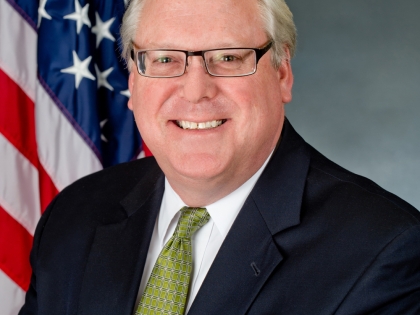
O'Mara: Budget increases state aid to local schools, supports local infrastructure, broadband development, agriculture, veterans and more
Thomas F. O'Mara
April 1, 2015
-
ISSUE:
- Budget

Albany, N.Y., April 1—State Senator Tom O’Mara (R-C, Big Flats) said today that the 2015-2016 New York State budget includes higher state aid to local schools, a stronger commitment to local infrastructure and broadband development, and enhanced assistance to key economic sectors including agriculture.
After reaching the framework of an agreement on the new, nearly $142-billion state budget over the weekend, the Legislature put the finishing touches on the plan last night and the new budget was delivered to Governor Andrew Cuomo to be signed into law.
“This budget targets key Upstate industries like agriculture and tourism, helps local schools, and enhances state support for addressing critical Upstate challenges like local roads, bridges, universal broadband and other vital infrastructure,” said O’Mara. “I'm especially pleased that we're establishing a stronger state commitment to delivering effective treatment to our veterans who've returned home from the battlefield and are suffering from the devastating effects of Post-traumatic stress disorder. It's been a personal mission of mine to get behind efforts to provide our military men and women with effective treatment. This year's additional state support will make a difference for many veterans and their families and loved ones in New York State and nationally.”
O’Mara, who was appointed chairman of the Senate Environmental Conservation Committee earlier this session, said that the new state budget includes $177 million for the Environmental Protection Fund (EPF), a $15-million increase over last year. The EPF supports critical environmental initiatives including clean air and water projects, including flood control and restoration, and open space preservation. The budget will also include a new $200-million “Water Quality Infrastructure Improvement” fund to help localities undertake water infrastructure improvement projects including sewer and pipeline repairs. Also on the environmental front, the Legislature and the governor have agreed to extend the state’s brownfields cleanup program for 10 years and refocus the program on the cleanup of polluted properties Upstate.
O’Mara also welcomed the budget’s inclusion of $500 million for a “universal broadband” program to expand high-speed Internet availability to currently unserved and underserved regions, especially rural regions Upstate.
The budget also includes a modified version of a plan first put forth by the governor to establish a $1.5-billion Upstate Revitalization Fund for economic development. The budget further continues the accelerated elimination of the higher 18-a utility surcharge imposed on New Yorkers in 2009, a state-imposed cost that hits farmers, manufacturers and senior citizens facing high energy expenses especially hard.
Other highlights include:
-- a $50-million increase in funding for the Consolidated Highway Improvement Program (CHIPS) for localities, which will provide increases to counties, cities, towns and villages across the Southern Tier and Finger Lakes regions, and statewide.
“The improvement and upkeep of local roads and bridges is a wise use of taxpayer dollars. It’s an investment in economic growth and job creation throughout the Southern Tier and Finger Lakes regions, and all across New York,” said O’Mara, a member of the Senate Transportation Committee. O’Mara also noted that the Legislature has added $250 million to Cuomo’s proposed $750 million for the state Department of Transportation’s (DOT) road and bridge program;
-- an overall increase of $1.4 billion in general state support for public schools, an approximately six percent increase bringing total state aid to $23.5 billion, including the accelerated elimination of $603 million, or more than half, of the remaining Gap Elimination Adjustment (GEA) in the 2015-16 school year. The GEA has been a damaging and highly controversial move first enacted in 2009 that has hurt school districts locally and statewide over the past several years. O’Mara said that state senators are committed to fully eliminating the GEA next year.
“The elimination of the unfair and detrimental Gap Elimination Adjustment is a top priority for our local school districts, and it will remain a top priority for Senate Republicans. It’s a priority I strongly share. It’s time to completely eliminate the GEA,” said O’Mara. The GEA was originally enacted in 2009-2010 by then-Governor David Paterson, and when both houses of the Legislature were under Democratic control, as a way to help the state close a multi-billion-dollar budget gap. Republicans in the Senate at that time unanimously rejected the move as a budget-balancing scheme that would hurt local school districts;
-- increasing community college base aid by $100 per full-time equivalent student (FTE), resulting in a $13.8 million aid increase for community colleges statewide, including Corning, Tompkins Cortland and Finger Lakes;
-- $400 million in capital projects funding for Upstate rural hospitals;
-- $14 million for teacher centers;
-- funding of $800,000 for the Research & Recognition Project, which O’Mara and several of his Senate colleagues have been seeking to support the expansion of a groundbreaking treatment program for military servicemen and servicewomen suffering from Post-traumatic Stress Disorder (PTSD).
The project’s Executive Director is Dr. Frank J. Bourke of Corning, a clinical psychologist with more than three decades of experience in the field.
“The Research and Recognition Project has demonstrated effective advancements in this field. I’m a believer in this program,” said O’Mara; and
-- a new, $30-million “Southern Tier On-Farm Enhancement Program” and additional provisions of the Senate’s “Grown in New York” plan, which O’Mara cosponsors, a comprehensive legislative program blending tax and regulatory reform incentives, low-interest loans and grants, a student loan forgiveness program and other initiatives to help existing farmers stay on the land and encourage more young men and women to consider careers in agriculture.
Find out more about the 2015-2016 budget, and share your views HERE.
Share this Article or Press Release
Newsroom
Go to Newsroom


